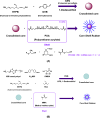A facile strategy for synthesizing isosorbide-based polyurethane structural adhesives and core-shell rubber
- PMID: 39251784
- PMCID: PMC11385552
- DOI: 10.1038/s41598-024-72053-3
A facile strategy for synthesizing isosorbide-based polyurethane structural adhesives and core-shell rubber
Abstract
A structural adhesive series of biomass-based polyurethane (Biomass-PU) is synthesized using polypropylene glycol (PPG2000), isosorbide-based polyol (RPO300) as polyols, isophorone diisocyanate (IPDI) as an isocyanate and 4-tert-butylphenol (BP) as a capping agent. Three different equivalent ratios of PPG2000/RPO300, 9/1 (Biomass-PU1), 7/3 (Biomass-PU2), and 1/1 (Biomass-PU3), are evaluated to determine the effect of isosorbide-based polyol content on the properties and the optimizing formulation of biomass-PU structure adhesive. The 9/1 ratio of PPG2000/RPO300 substantially leads to the improvement of impact strength by up to 35 MPa, and the PPG2000/RPO300 = 9/1 ratio exhibits better thermal properties and impact strength than those of other ratios. To achieve more compatibility between biomass-PU structure adhesive and core-shell rubber (CSR) toughener, novel CSRs are successfully synthesized using acryl-PU as a shell and biomass-based PU as a core. The chemical structure of biomass-PU structure adhesives is analyzed through FT-IR Spectroscopy and NCO% titration. Thermal properties are evaluated using TGA and DSC analysis. Their molecular weights are measured by GPC. Also, the core-shell rubber (CSR) with a polyurethane shell is prepared to reinforce the impact strength of Biomass-PU structure adhesive.
© 2024. The Author(s).
Conflict of interest statement
The authors declare no competing interests.
Figures









References
-
- Lee, H. R. et al. The effect of nano functionalized block copolymer addition on the joint strength of structural epoxy adhesive for car body assembly. J. Weld. Join.33, 44–49. 10.5781/JWJ.2015.33.4.44 (2015).10.5781/JWJ.2015.33.4.44 - DOI
-
- Kim, D. Y. et al. Effect of molecular weight of polyurethane toughening agent on adhesive strength and rheological characteristics of automotive structural adhesives. Int. J. Adhes. Adhes.74, 21–27. 10.1016/j.ijadhadh.2016.12.006 (2017).10.1016/j.ijadhadh.2016.12.006 - DOI
-
- Ruan, M., Luan, H., Wang, G. & Shen, M. Bio-polyols synthesized from bio-based 1,3-propanediol and applications on polyurethane reactive hot melt adhesives. Ind. Crops Prod.128, 436–444. 10.1016/j.indcrop.2018.11.045 (2019).10.1016/j.indcrop.2018.11.045 - DOI
-
- Borrero-López, A. M. et al. Toward UV-triggered curing of solvent-free polyurethane adhesives based on castor oil. ACS Sustain. Chem. Eng.9, 11032–11040. 10.1021/acssuschemeng.1c02461 (2021).10.1021/acssuschemeng.1c02461 - DOI
LinkOut - more resources
Full Text Sources

